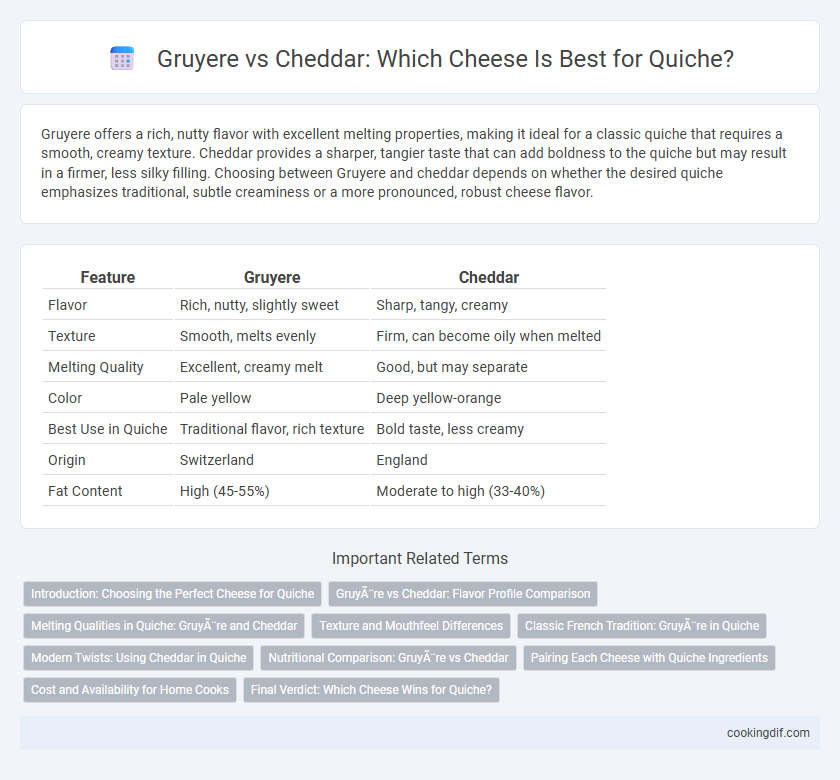Gruyere offers a rich, nutty flavor with excellent melting properties, making it ideal for a classic quiche that requires a smooth, creamy texture. Cheddar provides a sharper, tangier taste that can add boldness to the quiche but may result in a firmer, less silky filling. Choosing between Gruyere and cheddar depends on whether the desired quiche emphasizes traditional, subtle creaminess or a more pronounced, robust cheese flavor.
Table of Comparison
| Feature | Gruyere | Cheddar |
|---|---|---|
| Flavor | Rich, nutty, slightly sweet | Sharp, tangy, creamy |
| Texture | Smooth, melts evenly | Firm, can become oily when melted |
| Melting Quality | Excellent, creamy melt | Good, but may separate |
| Color | Pale yellow | Deep yellow-orange |
| Best Use in Quiche | Traditional flavor, rich texture | Bold taste, less creamy |
| Origin | Switzerland | England |
| Fat Content | High (45-55%) | Moderate to high (33-40%) |
Introduction: Choosing the Perfect Cheese for Quiche
Gruyere cheese offers a rich, nutty flavor and melts smoothly, making it ideal for traditional quiche recipes. Cheddar provides a sharper, tangier taste that adds a bold twist to classic quiche fillings. Selecting between Gruyere and cheddar depends on the desired flavor profile and texture for the quiche.
Gruyère vs Cheddar: Flavor Profile Comparison
Gruyere offers a nutty, slightly sweet flavor with a smooth, creamy texture that melts evenly in quiche, enhancing its richness without overpowering other ingredients. Cheddar provides a sharper, more pronounced tanginess and crumbly texture, which can create a bolder taste but may alter the traditional quiche balance. Choosing Gruyere maintains the classic delicate flavor profile, while Cheddar adds a robust intensity suitable for those seeking a more distinctive cheese presence in quiche.
Melting Qualities in Quiche: Gruyère and Cheddar
Gruyere cheese offers a smooth, creamy melt that enhances the quiche's texture with a rich, slightly nutty flavor, creating a cohesive custard consistency. Cheddar, while flavorful and sharper, tends to melt less uniformly, sometimes resulting in a firmer, more textured filling. For a silky, well-blended quiche, Gruyere's superior melting qualities make it the preferred choice among chefs and home cooks alike.
Texture and Mouthfeel Differences
Gruyere offers a smooth, creamy texture that melts evenly, creating a rich and velvety mouthfeel in quiche. Cheddar tends to be firmer and sharper, providing a more crumbly texture that can result in a slightly grainy sensation when baked. The choice between Gruyere and cheddar significantly impacts the quiche's overall creaminess and how the cheese integrates with other ingredients.
Classic French Tradition: Gruyère in Quiche
Gruyere cheese is the quintessential choice for traditional French quiche, offering a smooth, nutty flavor and exceptional melting qualities that enhance the custard filling's texture. Unlike cheddar, which brings a sharper, more pronounced taste, Gruyere maintains the delicate balance of savory and creamy that defines classic quiche Lorraine and other regional varieties. Its superior meltability and subtle complexity make Gruyere essential for achieving authentic French quiche flavor and consistency.
Modern Twists: Using Cheddar in Quiche
Gruyere is traditionally favored for quiche due to its creamy texture and nutty flavor, which melts smoothly to create a rich custard base. Modern twists often incorporate cheddar for its sharper, tangier taste and vibrant orange hue, adding a bold depth that contrasts with classic quiche ingredients like spinach or bacon. Cheddar's firmer melt profile can produce a slightly sturdier filling, appealing to contemporary palates seeking more pronounced cheese flavors in a quiche.
Nutritional Comparison: Gruyère vs Cheddar
Gruyere cheese contains about 117 calories and 9 grams of fat per ounce, with 8 grams of protein, offering a rich source of calcium and vitamin A, while cheddar cheese has approximately 113 calories, 9.3 grams of fat, and 7 grams of protein per ounce, along with similar calcium levels. Both cheeses provide essential nutrients but Gruyere tends to have a slightly higher protein content and a creamier texture ideal for quiche. Cholesterol and sodium levels are comparable, making either cheese a nutritious choice depending on flavor preference in quiche recipes.
Pairing Each Cheese with Quiche Ingredients
Gruyere pairs exceptionally well with quiche ingredients such as spinach, mushrooms, and caramelized onions, enhancing their nutty and slightly sweet flavors. Cheddar's sharper, tangier profile complements robust fillings like bacon, broccoli, and tomatoes, adding a bold depth to the dish. Selecting the right cheese depends on balancing flavor intensity with the chosen vegetables or meats to create a harmonious quiche.
Cost and Availability for Home Cooks
Gruyere offers a rich, nutty flavor that elevates quiche but tends to be pricier and less widely available in regular grocery stores compared to cheddar. Cheddar provides a more affordable and accessible option for home cooks, with many varieties found easily on supermarket shelves. Balancing budget and convenience, cheddar remains a practical choice, while Gruyere is preferable for those seeking a more authentic, gourmet taste.
Final Verdict: Which Cheese Wins for Quiche?
Gruyere cheese delivers a rich, nutty flavor and melts smoothly, making it the preferred choice for authentic quiche recipes. Cheddar offers a sharper taste and a firmer texture, which can overpower delicate quiche fillings and create a denser consistency. For a perfectly balanced, traditional quiche with creamy texture and subtle complexity, Gruyere is the final verdict cheese winner.
Gruyère vs cheddar for quiche cheese Infographic

 cookingdif.com
cookingdif.com